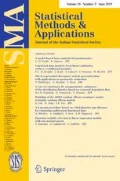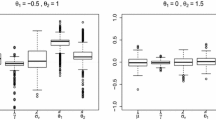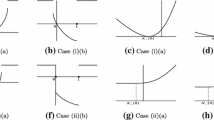Abstract
In this paper we compute the asymptotic variance-covariance matrix of the method of moments estimators for the canonical Stochastic Volatility model. Our procedure is based on a linearization of the initial process via the log-squared transformation of Breidt and Carriquiry (Modelling and prediction, honoring Seymour Geisel. Springer, Berlin, 1996). Knowledge of the asymptotic variance-covariance matrix of the method of moments estimators offers a concrete possibility for the use of the classical testing procedures. The resulting asymptotic standard errors are then compared with those proposed in the literature applying different parameter estimates. Applications on simulated data support our results. Finally, we present empirical applications on the daily returns of Euro-US dollar and Yen-US dollar exchange rates.

Similar content being viewed by others
References
Andersen TG, Sørensen BE (1996) GMM estimation of a stochastic volatility model: a Monte Carlo study. J Bus Econ Stat 14(3):328–352
Bartolucci F, De Luca G (2001) Maximum likelihood estimation of a latent variable time-series model. Appl Stoch Models Bus Ind 17:5–17
Breidt FJ, Carriquiry AL (1996) Improved quasi-maximum likelihood estimation for stochastic volatility models. In: Zellner A, Lee JS (eds) Modelling and prediction, honoring Seymour Geisel. Springer, Berlin
Broto C, Ruiz E (2004) Estimation methods for stochastic volatility models: a survey. J Econ Surv 18:613–649
Chaussé P and Xú D (2012) GMM estimation of a stochastic volatility model with realized volatility: a Monte Carlo study. Working papers no. 1203, Department of Economics, University of Waterloo, Canada
Chib S, Nardari F, Shephard N (2002) Markov chain Monte Carlo methods for stochastic volatility models. J Econom 108:281–316
Dhaene G (2004) Indirect inference for stochastic volatility models via the log-squared observations. Tijdschr Econ Manag XLIX(3):421–440
Dhaene G, Vergote O (2003) Asymptotic results for GMM estimators of stochastic volatility models. Center for Economic Studies. Discussion paper series 03.06. Katholieke Universiteit Leuven, Belgium
Francq C, Zakoïan JM (2006) Linear-representation based estimation of stochastic volatility models. Scand J Stat 33(4):785–806
Fridman M, Harris L (1998) A maximum likelihood approach for non-Gaussian stochastic volatility models. J Bus Econ Stat 16:284–291
Fuller WA (1996) Introduction to statistical time series. Wiley, New York
Gallant AR, Tauchen G (1996) Which moments to match? Econom Theory 12:657–681
Gouriéroux C, Monfort A, Renault E (1993) Indirect inference. J Appl Econom 8:S85–S118
Harvey AC, Shephard N (1996) Estimation of an asymmetric model of asset prices. J Bus Econ Stat 14(4):429–434
Jacquier E, Polson NG, Rossi PE (1994) Bayesian analysis of stochastic volatility models. J Bus Econ Stat 12(4):69–87
Knight JL, Satchell SE, Yu J (2002) Estimation of the stochastic volatility model by the empirical characteristic function method. Aust N Z J Stat 44(3):319–335
Monfardini C (1998) Estimating stochastic volatility models through indirect inference. Econom J 1:113–128
Nelson DB (1994) Comment on Bayesian analysis of stochastic volatility models. J Bus Econ Stat 12(4):403–406
Rue H, Martino S, Chopin N (2009) Approximate Bayesian inference for latent Gaussian models by using integrated nested Laplace approximations. J R Stat Soc B 71(2):319–392
Ruiz E (1994) Quasi-maximum likelihood estimation of stochastic volatility models. J Econom 63:289–306
Sandmann G, Koopman SJ (1998) Estimation of stochastic volatility models via Monte Carlo maximum likelihood. J Econom 87:271–301
Taylor SJ (1994) Modelling stochastic volatility. Math Financ 4:183–204
Tsyplakov A (2010) Revealing the arcane: an introduction to the art of stochastic volatility models. Munich personal RePEc archive (MPRA). Paper no. 25511. Munich, Germany. http://mpra.ub.uni-muenchen.de/25511/
Author information
Authors and Affiliations
Corresponding author
Appendices
Appendix 1: Computation of \(V_{\eta }\)
The elements of \(\widehat{\eta }\) are the sample mean \(\widehat{m}_X\), the sample variance \(\widehat{\gamma }_X (0)\) and the sample first-order autocovariance \(\widehat{\gamma }_X (1)\) of \(x_t = \log y^2_t\). Thus the asymptotic variance-covariance matrix is
where
and
Write \(x_t^{*}\) as \(h_t^{*} + e_t\), where \(h^{*}_t = h_t - \mu (1 - \rho )^{-1}\) and \(e_t = \log u^2_t - c_1\). Then the transition equation in (2.1) becomes \(h_t^{*} = \rho h^{*}_{t - 1} + v_t\). Now \(e_t\) and \(h^{*}_t \) have zero mean and are independent. Furthermore, we have
for any integers i, j and \(\ell \). Using these formulae, the elements of \(V_{\eta } \) are derived as follows:
Appendix 2: Proof of Theorem A
Set \(\theta = \left( \mu \, \, \rho \, \, \sigma _{v}^2\right) ^{'}\) and \(\eta =(m_X \, \, \gamma _{X}(0) \, \, \gamma _{X}(1))^{'}\). Let \(\Theta = \mathbb {R} \times (- 1, 1) \times (0, + \infty )\) be the open space of the parameter vector \(\theta \). Let \(\eta = \eta (\theta )\) be the map from \(\Theta \) into \(\mathbb {R}^3\) defined by Eqs. (2.3), (2.5) and (2.6). This map is injective and formed by rational functions, hence it is differentiable. The Jacobian matrix \(J = \frac{\partial \, \eta }{\partial \, \theta ^{'}}\) has full rank as \(\det J = - (1 + \rho ) \, (1 - \rho ^2)^{-3}\, \sigma _{v}^{2} \ne 0\) for \(|\rho | < 1\). The inverse map \(\theta = \theta (\eta )\) from the image of \( \eta \) into \(\Theta \) is defined by the equations
where \(\gamma _X (0) \ne c_2 = \sigma _{e}^2\) by (2.5). Let \(\widehat{\theta }\) be the MM estimator of \(\theta \) in Model (1.1). As T grows larger, \(\widehat{\mu }\), \(\widehat{\rho }\), and \(\widehat{\sigma }^2_v\) converge to their population counterparts (or probability limits). Let \({\widehat{\eta }}_T = ({{\widehat{m}}}_X \, \, {\widehat{\gamma }}_X (0)\, \, {\widehat{\gamma }}_X (1))^{'}\) be the sample estimator of \(\eta \). Then \({\widehat{\eta }}_T \rightarrow \eta \) as \(T \rightarrow \infty \). Substituting \( \widehat{m}_X\), \( \widehat{\gamma }_X (0)\) and \(\widehat{\gamma }_X (1)\) on the right–hand sides of (6.1) yields a consistent estimator of \(\theta \) that is asymptotically equivalent to \(\widehat{\theta }\). More precisely, the sequence \(\{ {\widehat{\eta }}_T \}\) satisfies \(\sqrt{T} ({\widehat{\eta }}_T - \eta ) \rightarrow \mathcal{N}(0, V_{\eta })\) in distribution. Applying the Delta Method gives \(\sqrt{T} ({\widehat{\theta }}_T - \theta ) = \sqrt{T} (\theta ({\widehat{\eta }}_T) - \theta (\eta )) \rightarrow \mathcal{N}(0, V_{\theta })\) in distribution, where the asymptotic variance-covariance matrix \(V_{\theta }\) is given by \(\frac{\partial \, \theta }{\partial \, \eta ^{'}} \, V_{\eta }\, \frac{\partial \, \theta ^{'}}{\partial \, \eta } = J^{-1} \, V_{\eta } \, (J^{'})^{-1}\). This proves the statement.
Appendix 3: Proof of Theorem B
Set \(\theta _{*} = (\xi \, \, \beta \, \, \sigma _{w}^2)^{'}\) and \(\theta = (\mu \, \, \rho \, \, \sigma _{v}^2)^{'}\). Let \(\Theta _{*} = \mathbb {R} \times \{(- 1, 0) \cup (0, 1) \} \times (0, + \infty )\) be the open space of the parameter vector \(\theta _{*}\). Let \(\theta = \theta (\theta _{*})\) be the map from \(\Theta _{*}\) into \(\mathbb {R}^3\) defined by the following equations which are derived from Sect. 3:
This map is differentiable. The Jacobian matrix \(D = \frac{\partial \, \theta }{\partial \theta _{*}^{'}}\) has full rank as \(\det D = \sigma _{w}^2 \, \sigma _{e}^{- 2}\, (\beta ^2-1) \ne 0\) for \(|\beta | <1\). The map \(\theta = \theta (\theta _{*})\) is injective and the identification problem is completely solved as the transformation \(\theta _{*} = \theta _{*} (\theta )\) from the image of \( \theta \) into \(\Theta _{*}\) is derived as follows. Substituting (3.5) into (3.4) and then multiplying by \(\beta \), we get
which gives
where
Note that \(- \sqrt{\Delta }\) in (6.4) is not acceptable since \( | \beta | < 1\) (and \(\beta \ne 0\)). This condition ensures the invertibility of the process. In particular, if \(\rho >0\), then we have \(-1< \beta <0\). From (6.4) and (3.5) we obtain
Now the equations of the map \(\theta _{*} = \theta _{*} (\theta )\) can be easily derived from (3.2), (6.4) and (6.5). From Theorem A we have \({\widehat{\theta }}_T \rightarrow \theta \) as T goes to \( \infty \) and \(\sqrt{T} ({\widehat{\theta }}_T - \theta ) \rightarrow \mathcal{N}(0, V_{\theta })\) in distribution. Applying the Delta Method gives \(\sqrt{T} ({\widehat{\theta }}_{* T} - \theta _{*}) = \sqrt{T} (\theta _{*}({\widehat{\theta }}_T) - \theta _{*}(\theta )) \rightarrow \mathcal{N}(0, V_{\theta _{*}})\) in distribution, where
This proves the statement.
Rights and permissions
About this article
Cite this article
Cavicchioli, M. Estimation and asymptotic covariance matrix for stochastic volatility models. Stat Methods Appl 26, 437–452 (2017). https://doi.org/10.1007/s10260-016-0373-8
Published:
Issue Date:
DOI: https://doi.org/10.1007/s10260-016-0373-8
Keywords
- Stochastic volatility
- Asymptotically stationary process
- Consistency
- Asymptotic normality
- Asymptotic variance-covariance matrix
- Financial returns




